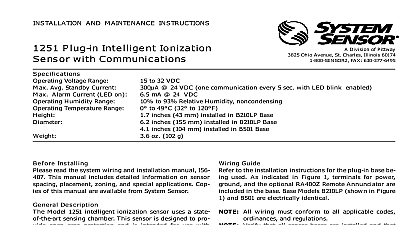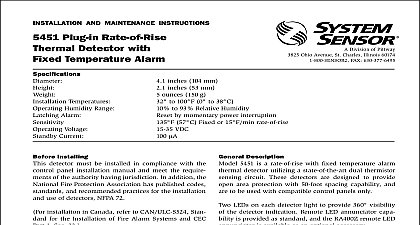System Sensor b501 Install and Maint Instructions

File Preview
Click below to download for free
Click below to download for free
File Data
| Name | system-sensor-b501-install-and-maint-instructions-0314598726.pdf |
|---|---|
| Type | |
| Size | 684.85 KB |
| Downloads |
Text Preview
SYsTEM SENSOR Division of Pittway 3825 Ohio Avenue St Charles Illinois 60174 FAX 630 377 6495 AND MAINTENANCE INSTRUCTIONS Plug in Detector Base inches 10.2cm 60mm and 70mm centers Ratings includes base and detector Range Current nominal Surge at Maximum Rated Voltage Current nominal at 24 VDC VDC at 24 VDC Installing thoroughly read the System Sensor manual I56 407 for Proper Use of System Smoke Detectors which detailed information on detector spacing place zoning wiring and special applications Copies of manual are available at no charge from System Sensor Description plug in detector base is used with System Sensor 200 500 Series detectors B501 base is intended for use in an intelligent system screw terminals provided for power and and annunciator connections The communication takes over the power and lines Terminals Remote Annunciator Annunciator 1 Terminal layout PROOF Manuals Online 2 Typical wiring diagram for 2 wire loop ANNUNCIATOR base contains a label to write the zone address and of detector to be installed at that location This infor is used to set the address of the detector head that later be plugged into the base and to verify the type re for that location Installation Guidelines See Figure 2 wiring must be installed in compliance with the Na Electrical Code and the local authority having juris Proper wire gauges should be used The used to connect the smoke detectors to control and accessory devices should be color coded to pre wiring mistakes Improper connections can prevent a form responding properly in the event of a fire signal wiring the wiring between interconnected de and modules it is recommended that the wiring be smaller than 18 gauge 1.0 square mm Wire sizes up 12 gauge wire 2.5 square mm may be used with the For best system performance the power and wires should be twisted pair or shielded cable in in separate grounded conduit to protect the loop extraneous electrical interference If a cable shield is the shield connection to and from the base must continuous by using wire nuts crimping or soldering as for a reliable connection Connections are made by simply stripping about 3 8 insulation from the end of the wire use strip gauge in base sliding the bare end of the wire under the plate and tightening the clamping plate screw Do loop the wire under the clamping plate zone wiring of the detector base should be checked the detector heads are installed in them The wiring be checked for continuity polarity in the base and tests Manuals Online Figure 3A Activating tamperproof feature 3B Removing detector head from base LEVER TAB AT LINE BY TOWARD OF BASE SMALL BLADED TO PLASTIC LEVER DIRECTION OF 4 Connection to remote annunciator terminal WIRE WITH LUG Feature detector base also includes an optional tamperproof that when activated prevents removal of the detec without the use of a tool activate this feature simply break off the tab on the de base shown in Figure 3A and install the detector To the detector from the base once the tamperproof has been activated place a small bladed screw into the small hole on the side of the base and push plastic lever away from the detector head see Figure This will allow the detector to be rotated counterclock for removal tamperproof feature may be defeated by breaking and the plastic lever from the base however this pre ever using the feature again Annunciator RA400 remote annunciator is connected between terminals 1 3 using the spade lug terminal packed with the remote The spade lug terminal is connected to the terminal as shown in Figure 4 is not acceptable to have three stripped wires under the wiring terminal unless they are separated by a or equivalent means The spade lug supplied with model RA400 is considered an equivalent means See 2 for proper installation Manuals Online Limitations of Property Protection Smoke Detectors smoke detector used with this base is designed to activate and ini emergency action but will do so only when it is used in conjunction an authorized fire alarm system This detector must be installed in with NFPA standard 72 detectors will not work without power AC or DC powered detectors will not work if the power supply is cut off of fires Ionization detectors offer a broad range of fire sensing capa but they are somewhat better at detecting fast flaming fires than smoldering fires Photoelectric detectors sense smoldering fires better flaming fires which have little if any visible smoke Because fires de in different ways and are often unpredictable in their growth nei type of detector is always best and a given detector may not always early warning of a specific type of fire detectors will not sense fires which start where smoke does not the detectors Smoldering fires typically do not generate a lot of which is needed to drive the smoke up to the ceiling where the detector is usually located For this reason there may be large de in detecting a smoldering fire with either an ionization type detector a photoelectric type detector Either one of them may alarm only after has initiated which will generate the heat needed to drive the to the ceiling from fires in chimneys in walls on roofs or on the other side of a door s may not reach the smoke detector and alarm it A detector detect a fire developing on another level of a building quickly or at For these reasons detectors shall be located on every level and in bedroom within a building detectors have sensing limitations too Ionization detectors and detectors are required to pass fire tests of the flaming and type This is to ensure that both can detect a wide range of general detectors cannot be expected to provide warnings for fires re from inadequate fire protection practices violent explosions es gases which ignite improper storage of flammable liquids like solvents which ignite other similar safety hazards arson smok in bed children playing with matches or lighters etc Smoke detectors in high air velocity conditions may have a delay in alarm due to dilu of smoke densities created by frequent and rapid air exchanges Addi high air velocity environments may create increased dust demanding more frequent maintenance keep your equipment in excellent working order ongoing maintenance required per the manufacturer recommendations and UL and NFPA At a minimum the requirements of Chapter 7 of NFPA 72 the Fire Alarm Code shall be followed A preventative maintenance should be arranged through the local manufacturer represen Though smoke detectors are designed for long life they may fail at time Any smoke detector fire alarm equipment or any component of system which fails shall be repaired or replaced as soon as possible Limited Warranty Sensor warrants its enclosed smoke detector base to be free from in materials and workmanship under normal use and service for a of three years from date of manufacture System Sensor makes no express warranty for this smoke detector base No agent representa dealer or employee of the Company has the authority to increase or the obligations or limitations of this Warranty The Company obli of this Warranty shall be limited to the repair or replacement of any of the smoke detector base which is found to be defective in materials workmanship under normal use and service during the three year pe commencing with the date of manufacture After phoning System toll free number 800 SENSOR2 736 767


